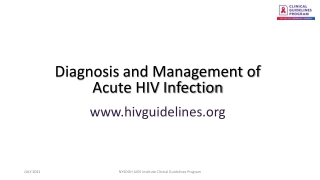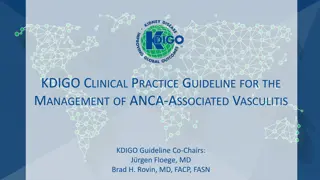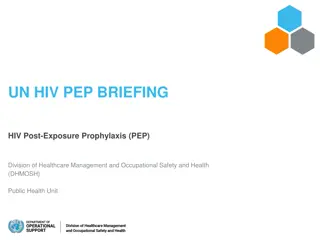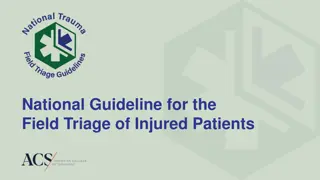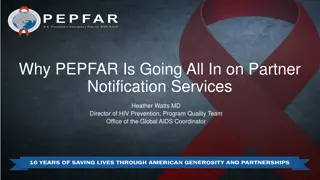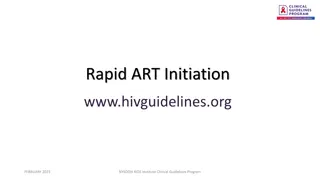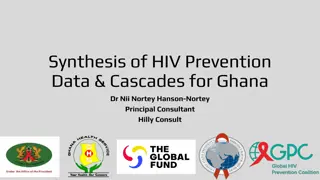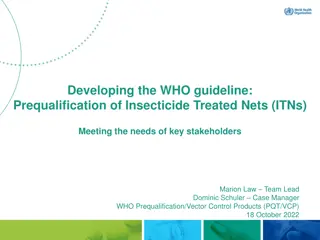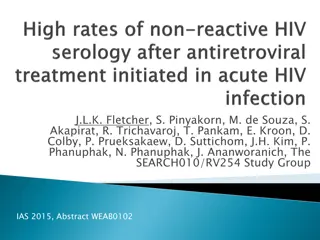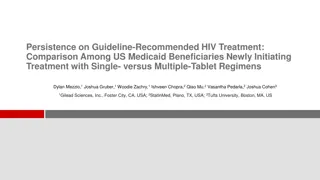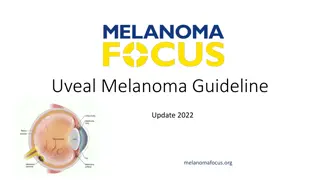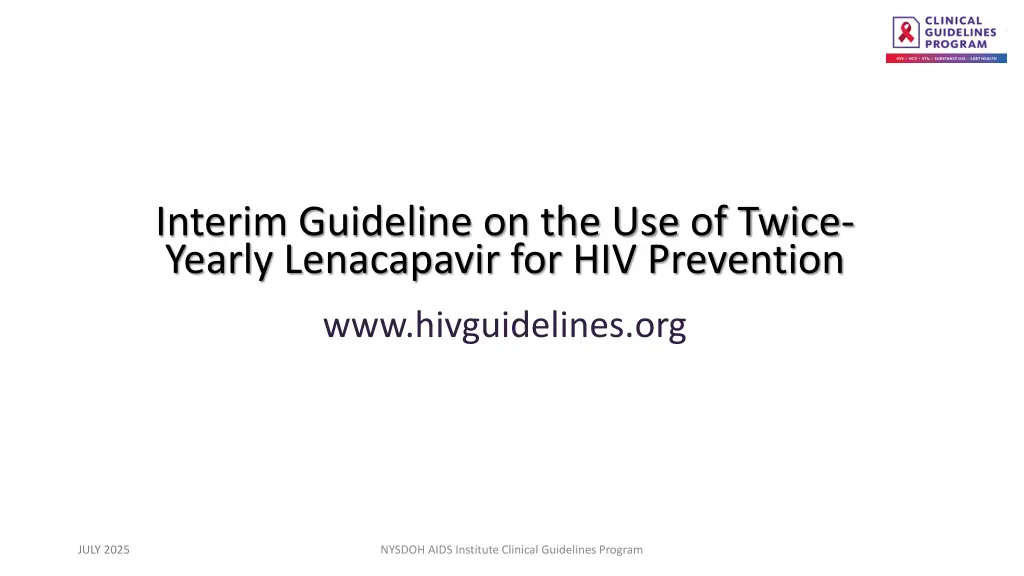
Use of Lenacapavir for HIV Prevention
Interim guideline on the use of twice-yearly lenacapavir (LEN) for HIV prevention, approved by the U.S. Food and Drug Administration in June 2025. This guideline provides recommendations for the administration, dosing, preparation, and storage of lenacapavir as pre-exposure prophylaxis (PrEP) against HIV through sexual exposure. Clinicians are advised on the preferred PrEP regimen, discussions with individuals on potential risks and benefits, and proper administration techniques. The document outlines the dosing schedule, initiation doses, maintenance doses, and instructions for preparation and injection of lenacapavir. Relevant information such as how lenacapavir is supplied, storage conditions, injection techniques to minimize discomfort, and guidance on engaging pregnant individuals in decision-making is included.
Download Presentation

Please find below an Image/Link to download the presentation.
The content on the website is provided AS IS for your information and personal use only. It may not be sold, licensed, or shared on other websites without obtaining consent from the author. If you encounter any issues during the download, it is possible that the publisher has removed the file from their server.
You are allowed to download the files provided on this website for personal or commercial use, subject to the condition that they are used lawfully. All files are the property of their respective owners.
The content on the website is provided AS IS for your information and personal use only. It may not be sold, licensed, or shared on other websites without obtaining consent from the author.
E N D
Presentation Transcript
Interim Guideline on the Use of Twice- Yearly Lenacapavir for HIV Prevention www.hivguidelines.org JULY 2025 NYSDOH AIDS Institute Clinical Guidelines Program
Purpose of This Guideline Purpose of This Guideline In June 2025, the U.S. Food and Drug Administration approved lenacapavir (LEN), a long-acting HIV capsid inhibitor given subcutaneously every 6 months (along with an initial 2-day oral loading dose), for use as HIV PrEP for sexual exposures in adults and adolescents weighing 35 kg. The full PrEP guideline, PrEP to Prevent HIV and Promote Sexual Health, is undergoing an update. This guideline was developed by the NYSDOH AI Clinical Guidelines Program with the goal of providing interim guidance on the use of subcutaneous LEN as PrEP. JULY 2025 NYSDOH AIDS Institute Clinical Guidelines Program www.hivguidelines.org
Recommendations Recommendations Indication: Clinicians should recommend subcutaneous (SC) LEN as a preferred PrEP regimen for protection against HIV through sexual exposure for individuals who are willing to receive SC injections every 6 months and have no contraindications or barriers to its use. (A1) For other preferred PrEP regimens, see the NYSDOH AI guideline PrEP to Prevent HIV and Promote Sexual Health. Clinicians should discuss potential risks and benefits and engage individuals who are or may become pregnant in shared decision-making when considering SC LEN as PrEP. (A3) Dosing, Preparation, and Administration: Clinicians should administer SC LEN as indicated in Dosing, Preparation, and Administration of SC LEN as PrEP. (A1) JULY 2025 NYSDOH AIDS Institute Clinical Guidelines Program www.hivguidelines.org
Dosing, Preparation, and Administration of SC LEN as PrEP Dosing, Preparation, and Administration of SC LEN as PrEP How Supplied Injection: 463.5 mg/1.5 mL (309 mg/mL) in 2 single-dose vials, 2 vial access devices, 2 disposable syringes, and 2 injection safety needles for SC injection (22 gauge, inch) Tablets: 300 mg Oral LEN tablets should be stored at room temperature, between 68 and 77 F, in their original packaging. SC LEN vials should be stored at room temperature, between 68 and 77 F, with excursions permitted at 59 to 86 F. Vials should be kept in their original carton until just before use to protect from light. Do not shake the vial before injection. Initiation Dose Day 1: 927 mg (3 mL) LEN by SC injection (two 1.5 mL injections in separate areas) plus 600 mg LEN orally (two 300 mg tablets) Day 2: 600 mg LEN orally (two 300 mg tablets) Maintenance Dose Every 6 months (26 weeks), plus or minus 2 weeks, from the date of the last injection: 927 mg (3 mL) LEN by SC injection (two 1.5 mL injections in separate areas) Preparation and Administration Use of ice packs before and after, and analgesics after injections significantly decreases discomfort from injection site reactions (ISRs). Once the solution has been drawn into the syringes, administer as soon as possible. Discard solution if not used within 4 hours. SC LEN injections are administered at a 90 angle to decrease the risk of ISRs. The preferred site of administration is the abdomen, placing the 2 injections on opposite sides. One injection into each lateral thigh can be used as an alternative injection site if preferred. SC LEN is not appropriate for self- injection and should be administered by a healthcare professional. JULY 2025 NYSDOH AIDS Institute Clinical Guidelines Program www.hivguidelines.org
Key Points: Dosing, Administration, and Other Key Points: Dosing, Administration, and Other Considerations Considerations Apply ice packs to the planned injection sites for 10 minutes before injection and use analgesics as needed to decrease discomfort from ISRs. Administer SC LEN injections at a 90 angle to decrease the risk of ISRs. The day 2 dose of oral LEN is necessary to assure adequate LEN levels during initiation. Supplemental doses of SC LEN are recommended for individuals initiating either strong or moderate CYP3A inducers. JULY 2025 NYSDOH AIDS Institute Clinical Guidelines Program www.hivguidelines.org
Initiation Visit for SC LEN as PrEP Initiation Visit for SC LEN as PrEP Assessment: Assess for signs and symptoms of acute HIV infection. Review prescribed medications and inquire about any over-the-counter medications or supplements for potential drug-drug interactions with LEN. Assess need for additional support for behavioral health, primary care, reproductive health, substance use, housing, or other medical and social services. Laboratory testing: Laboratory-based HIV Ag/Ab test within 7 days of initiation or a rapid HIV Ag/Ab test on the day of initiation pending laboratory-based HIV Ag/Ab confirmation HIV RNA PCR assay to rule out acute HIV infection in individuals not already taking and adherent to PrEP STI testing as per routine PrEP protocols (see NYSDOH AI guideline PrEP to Prevent HIV and Promote Sexual Health > Ongoing Laboratory Testing > STI screening) HBsAg, anti-HBs, and anti-HBc testing to rule out active HBV infection and assess need for HBV vaccination if an individual s hepatitis serologies are unknown or if there was borderline or low-level immunity in the past JULY 2025 NYSDOH AIDS Institute Clinical Guidelines Program www.hivguidelines.org
Initiation Visit for SC LEN as PrEP Initiation Visit for SC LEN as PrEP, continued Education: Discuss the importance of adherence to the oral lead-in dose of LEN and provide the dosing pack for self-administration on the following day (day 2). Discuss potential adverse effects and ways to mitigate discomfort associated with ISRs (e.g., using ice and over-the-counter analgesics). Ensure individuals know how to contact the care team with questions or concerns. Review the timeframe for subsequent injections, and the importance of communication with the care team if an appointment will be rescheduled or missed. Review the availability of oral bridging medication should an injection need to be delayed beyond 28 weeks (6 months plus 2 weeks). Follow-up: Schedule the follow-up injection visit for 6 months (plus or minus 2 weeks) from the current visit. Consider an interim 3-month HIV testing and STI screening visit based on risk (can defer HIV/STI screening if the individual is low risk) or plan for interim STI testing at an external laboratory; if appropriate, discuss doxy-PEP for bacterial STI prevention (see NYSDOH AI guideline Doxycycline Post- Exposure Prophylaxis to Prevent Bacterial Sexually Transmitted Infections). JULY 2025 NYSDOH AIDS Institute Clinical Guidelines Program www.hivguidelines.org
Continuation Visit for SC LEN as PrEP Continuation Visit for SC LEN as PrEP Assess for signs and symptoms of acute HIV infection. Confirm continued interest in PrEP and review PrEP options. Assess for ISRs since last visit and review management options. Review prescribed and over-the-counter medications to assess for drug-drug interactions. Confirm a negative laboratory-based HIV Ag/Ab test result within the past 7 days or a rapid Ag/Ab test with a laboratory-based HIV Ag/Ab test on day of visit. A NAAT (HIV viral load test) is not required for on-time dosing. Perform STI screening as per PrEP protocols and discuss doxy-PEP as appropriate (see links above). Schedule the follow-up injection visit for 6 months (plus or minus 2 weeks). Stress the importance of communication with the individual s care team for any changes to scheduled visits or insurance. Review the availability of oral bridging medication should an injection need to be delayed beyond 28 weeks (6 months plus 2 weeks). Assess need for additional support for behavioral health, primary care, reproductive health, substance use, housing, or other medical and social services. JULY 2025 NYSDOH AIDS Institute Clinical Guidelines Program www.hivguidelines.org
Managing Missed Injections Managing Missed Injections Planned missed injection >14 days late (>28 weeks since the last injection): If an individual misses their LEN injection for a planned reason, initiate oral LEN 300 mg once every 7 days (beginning when the injection is due) and continue until SC LEN can be administered, up to a maximum of 6 months (26 weeks). If the injection is missed beyond 6 months (i.e., more than 52 weeks since the last injection), transition the individual to another PrEP regimen if they plan to continue PrEP. If oral LEN is not available for bridging, prescribe another oral PrEP regimen. Unplanned missed injection >14 days late (>28 weeks since the last injection): If an individual misses their SC LEN injection for an unplanned reason, determine why the individual is unable to return and refer them for appropriate services as needed. Offer the individual oral LEN or another oral PrEP regimen as noted above for planned missed injections. JULY 2025 NYSDOH AIDS Institute Clinical Guidelines Program www.hivguidelines.org
Implementation Strategies for SC LEN as PrEP Implementation Strategies for SC LEN as PrEP Educate about the use of oral bridging therapy when appropriate. Educate about possible adverse effects of LEN and how to manage them. Ensure that individuals know how to reach the care team if needed. Schedule follow-up appointments for administration in advance. Institutional and clinician preparations: Assess pharmacy resources and on-site procedures for storage of oral and injectable medications. Develop procedures for obtaining prior authorizations for insurance and third-party coverage. Train medical care providers on the protocols for LEN use and monitoring. Train nurses and other medical care providers regarding proper syringe preparation and injection techniques. Establish billing protocols for the procurement and administration of injectable PrEP. Implement an appointment-reminder system and make call-backs after missed doses. Plan for treatment continuation during shutdowns or other catastrophic events. PrEP recipient preparations: Confirm the ability to maintain required clinic visit schedule for injections, including transportation availability. Advise on the importance of communicating with the team regarding any insurance and coverage changes. JULY 2025 NYSDOH AIDS Institute Clinical Guidelines Program www.hivguidelines.org
Benefits of Available PrEP Regimens Benefits of Available PrEP Regimens All PrEP Regimens Oral PrEP With TDF/FTC or TAF/FTC Injectable PrEP With CAB LA Injectable PrEP With SC LEN Highly effective when taken as directed May decrease anxiety regarding HIV acquisition Engages sexually active at-risk individuals in care who are then screened regularly for STIs 99% effective in reducing the risk of HIV acquisition when used as prescribed TDF/FTC: Indicated for all sexual and injection exposures TAF/FTC: Indicated for sexual exposures in MSM and in transgender women who have sex with men Single tablet taken daily, or for TDF/FTC can also be taken before and after sex Good safety profiles in people who do not have HIV Minimal adverse effects, most of which resolve quickly or can be managed TDF/FTC appears to be safe for use during attempts to conceive and during pregnancy Treats HBV infection Statistical superiority to TDF/FTC has been attributed to a lack of adherence to the oral regimen Indicated for all sexual exposures Administered intramuscularly once every 2 months Directly observed therapy Advantageous option when adherence to oral PrEP may be challenged by ongoing substance use or mental health concerns, neurocognitive disorders, difficulty swallowing pills, privacy concerns, or other challenges Statistical superiority to TDF/FTC has been attributed to a lack of adherence to the oral regimen Indicated for all sexual exposures Administered subcutaneously once every 6 months Directly observed therapy Advantageous option when adherence to oral PrEP may be challenged by ongoing substance use or mental health concerns, neurocognitive disorders, difficulty swallowing pills, privacy concerns, or other challenges JULY 2025 NYSDOH AIDS Institute Clinical Guidelines Program www.hivguidelines.org
Limitations of Available PrEP Regimens Limitations of Available PrEP Regimens All PrEP Regimens Oral PrEP With TDF/FTC or TAF/FTC Injectable PrEP With CAB LA Injectable PrEP With SC LEN Protection correlates with adherence to the dosing schedule No significant protection against STIs other than HIVs (some protection against HSV has been reported in heterosexual populations without HIV) Requires adherence to the daily administration schedule Requires planning and adherence when TDF/FTC is dosed on demand No data on TAF/FTC for individuals who inject drugs Requires additional monitoring in individuals with chronic HBV infection Cost of TAF/FTC (no generic available) Requires deep IM injection No data for individuals who inject drugs Requires oral medications as bridging therapy when injections are missed Requires 6 in-person healthcare visits per year Does not treat HBV infection Not appropriate for individuals with injectable silicone or other fillers in the gluteal area Implementation logistics Cost (no generic available) Increased risk of long-term impactful medication interactions Data pending for individuals who inject drugs Requires oral medications as bridging therapy when injections are missed Does not treat HBV infection Implementation logistics Cost (no generic available) JULY 2025 NYSDOH AIDS Institute Clinical Guidelines Program www.hivguidelines.org
Risks of Available PrEP Regimens Risks of Available PrEP Regimens All PrEP Regimens Potential for delayed detection of HIV infection using standard HIV testing algorithms Continued use after undiagnosed HIV infection may result in development of drug- resistant virus Oral PrEP With TDF/FTC or TAF/FTC Safety concerns for individuals with impaired kidney function Compared with TAF, TDF may be associated with reversible decreases in bone density Injectable PrEP With CAB LA Potential injection site reactions and other adverse events, including pyrexia Long tail phase once treatment is discontinued Potential for breakthrough infections despite on-time injections Injectable PrEP With SC LEN Injection site reactions are common (nodules, pain, and erythema at injection site) Long tail phase once treatment is discontinued Potential for breakthrough infections despite on-time injections JULY 2025 NYSDOH AIDS Institute Clinical Guidelines Program www.hivguidelines.org
Need Help? Need Help? NYSDOH AIDS Institute Clinical Guidelines Program www.hivguidelines.org
Access the Guideline Access the Guideline www.hivguidelines.org > Interim Guideline on the Use of Twice- Yearly Lenacapavir for HIV Prevention Also available: Printable pocket guide and PDF NYSDOH AIDS Institute Clinical Guidelines Program www.hivguidelines.org

